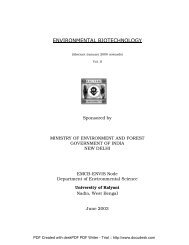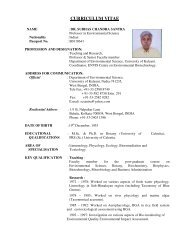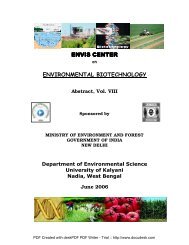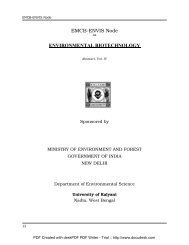EMCB-ENVIS Node ENVIRONMENTAL BIOTECHNOLOGY
EMCB-ENVIS Node ENVIRONMENTAL BIOTECHNOLOGY
EMCB-ENVIS Node ENVIRONMENTAL BIOTECHNOLOGY
You also want an ePaper? Increase the reach of your titles
YUMPU automatically turns print PDFs into web optimized ePapers that Google loves.
<strong>EMCB</strong>-<strong>ENVIS</strong> Centre<br />
Bioaccumulation<br />
A A Hamdy. (Microbial and Natural Products Chemistry Department, National Research<br />
Center, Dokki, Cairo, Egypt). Biosorption of Heavy Metals by Marine Algae. Current<br />
Microbiology, 41(4) (2000), 0232 – 0238.<br />
The ability of four different algae (three brown and one red) that have not been previously<br />
studied to adsorb Cr 3+ , Co 2+ , Ni 2+ , Cu 2+ , and Cd 2+ ions was investigated. The metal uptake was<br />
dependent on the type of biosorbent, with different accumulation affinities towards the tested<br />
elements. The HCl-treated biomass decreased the metal biosorptive capacity particularly in the<br />
case of Cr 3 adsorption with Laurencia obtusa. The extent of uptake of the different metals with<br />
the tested algae was assessed under different conditions such as pH, time of algal residence in<br />
solution with the metal, and concentration of algal biomass. The rate of uptake of the different<br />
metals was very fast in the first 2 h; thereafter the increase in metal uptake was insignificant. The<br />
amount of the metal uptake (5-15 mg range) increased steeply by increasing the weight of the<br />
biomass. An exception was L. obtusa, where a parallel increase of the uptake of different metals<br />
was observed on increasing the algal mass from 5 to 50 mg.<br />
A. E. El-Enany, A. A. Issa. (Botany Department, Faculty of Science, Assiut University,<br />
Assiut, Egypt). Cyanobacteria as a biosorbent of heavy metals in sewage water.<br />
Environmental Toxicology and Pharmacology, 8(2) (2000), 95-101.<br />
The effect of sewage water on some physiological activities of cyanobacteria was studied. Metaltolerant<br />
cyanobacterium (Nostoc linckia) and metal-sensitive (Nostoc rivularis) were grown at<br />
three levels of sewage water (25, 50 and 75%). The growth rate showed significant stimulation in<br />
low and moderate levels (50% for N. linckia and 25% for N. rivularis). Not only the number of<br />
cells was elevated but also, the time required to reach the exponential and the stationary phases<br />
was reduced. Also, low levels of sewage water increased chl.a content, photosynthetic O2evolution,<br />
respiration and protein content. Similarly, heterocyst frequency as well as nitrogenase<br />
activity were increased in cyanobacteria grown at low and moderate levels (25 and 50% sewage).<br />
On the other hand, the high level of waste (75%) reduced growth and metabolic activities of the<br />
two species. N. linckia accumulated about 30-fold of Zn and ten-fold of Cd than those of growth<br />
medium (50% sewage water). Also, N. rivularis accumulated about ten-fold of Zn and two-fold<br />
of Cd. The distribution of Cd and Zn in cells were investigated. About 65–60% of Cd or Zn were<br />
found in pellets (sediment) as insoluble form in the two species. The soluble form (cytosolic<br />
fraction) after being fractionated on sephadex G-(75-100) revealed two peaks with molecular<br />
weights of 70–75 and 40–45 kDa. These peaks were in coincidence with Cd and Zn maxima.<br />
Nostoc rivulais showed more sensitivity to heavy metals than N. linckia, and accumulated less<br />
amount of metal-binding proteins. Nostoc linckia seems to be tolerant to heavy metals (Zn and<br />
Cd) and is able to accumulate this metal by adsorption on the pellets (cell surface) and/or<br />
through sequestration via metal-binding protein. Therefore it can be recommended it to be<br />
employed in the purification of waste contaminated with these heavy metals.<br />
A. Heikens, W. J. G. M. Peijnenburg, A. J. Hendriks. (Institute for Inland Water Management<br />
and Waste Water Treatment, PO Box 17, 8200 AA Lelystad, The Netherlands. National<br />
Institute of Public Health and the Environment, PO Box 1, 3720 BA Bilthoven, The<br />
Netherlands). Bioaccumulation of heavy metals in terrestrial invertebrates.<br />
Environmental Pollution, 113(3) (2001), 385-393.<br />
In this literature study, accumulation data of metals in terrestrial invertebrates were collected and<br />
compared (Arthropoda and Lumbricidae). Based on total soil concentrations and body<br />
concentrations, regression equations were calculated for each metal (Cd, Cu, Pb and Zn) and<br />
each taxonomic group. We also tried to find out whether or not accumulation levels of metals in<br />
Lumbricidae are representative for all of the studied terrestrial invertebrates. Taxonomic groups<br />
20<br />
PDF Created with deskPDF PDF Writer - Trial :: http://www.docudesk.com







